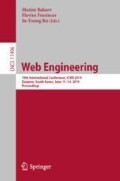Abstract
The evolution of the Web browser has been organic, with new features introduced on a pragmatic basis rather than following a clear rational design. This evolution has resulted in a cornucopia of overlapping features and redundant choices for developing Web applications. These choices include multiple architecture and rendering models, different communication primitives and protocols, and a variety of local storage mechanisms. In this position paper we examine the underlying reasons for this historic evolution. We argue that without a sound engineering approach and some fundamental rethinking there will be a growing risk that the Web may no longer be a viable, open software platform in the long run.
Access this chapter
Tax calculation will be finalised at checkout
Purchases are for personal use only
Notes
- 1.
- 2.
See for example the controversial decisions to provide standard support for Digital Rights Management in clear conflict with the Open Web Principle [6].
- 3.
- 4.
- 5.
Wikipedia https://en.wikipedia.org/wiki/Browser_wars in fact lists three separate browser wars (1995–2001, 2004–2018, 2018-present).
- 6.
- 7.
- 8.
- 9.
- 10.
- 11.
- 12.
- 13.
- 14.
- 15.
- 16.
References
MacLennan, B.J.: Principles of Programming Languages Design, Evaluation, and Implementation, 3rd edn. Oxford University Press, Oxford (1999)
Brooks Jr., F.P.: The Design of Design Essays from a Computer Scientist. Pearson Education, London (2010)
Taivalsaari, A., Mikkonen, T., Pautasso, C., Systa, K.: Comparing the built-in application architecture models in the web browser. In: 2017 IEEE International Conference on Software Architecture (ICSA), pp. 51–54. IEEE (2017)
Gallidabino, A., Pautasso, C.: Maturity model for liquid web architectures. In: Cabot, J., De Virgilio, R., Torlone, R. (eds.) ICWE 2017. LNCS, vol. 10360, pp. 206–224. Springer, Cham (2017). https://doi.org/10.1007/978-3-319-60131-1_12
Taivalsaari, A., Mikkonen, T., Systä, K., Pautasso, C.: Web user interface implementation technologies: an underview. In: Proceedings of the 14th International Conference on Web Information Systems and Technologies, WEBIST 2018, pp. 127–136. Seville, Spain, September 18–20 (2018)
Daubs, M.S.: HTML5, digital rights management (DRM), and the rhetoric of openness. J. Media Critiques (JMC) 3(9), 77–94 (2017)
Mikkonen, T., Taivalsaari, A.: Reports of the web’s death are greatly exaggerated. Computer 44(5), 30–36 (2011)
Flanagan, D.: JavaScript: The Definitive Guide, 6th edn. O’Reilly Media Inc., Sebastopol (2011)
Paulson, L.D.: Building rich web applications with Ajax. Computer 38(10), 14–17 (2005)
Anthes, G.: HTML5 leads a web revolution. Commun. ACM 55(7), 16–17 (2012)
Fraternali, P., Rossi, G., Sánchez-Figueroa, F.: Rich internet applications. IEEE Internet Comput. 14(3), 9–12 (2010)
Severance, C.: JavaScript: designing a language in 10 days. Computer 45(2), 7–8 (2012)
Richards, G., Gal, A., Eich, B., Vitek, J.: Automated construction of JavaScript benchmarks. In: Proceedings of the 2011 ACM International Conference on Object Oriented Programming Systems Languages and Applications, OOPSLA 2011, pp. 677–694. ACM, New York (2011)
Ater, T.: Building Progressive Web Apps: Bringing the Power of Native to the Browser. O’Reilly Media Inc., Sebastopol (2017)
Haas, A., et al.: Bringing the web up to speed with webassembly. In: ACM SIGPLAN Notices, vol. 52, pp. 185–200. ACM, New York (2017)
Author information
Authors and Affiliations
Corresponding author
Editor information
Editors and Affiliations
Rights and permissions
Copyright information
© 2019 Springer Nature Switzerland AG
About this paper
Cite this paper
Mikkonen, T., Pautasso, C., Systä, K., Taivalsaari, A. (2019). On the Web Platform Cornucopia. In: Bakaev, M., Frasincar, F., Ko, IY. (eds) Web Engineering. ICWE 2019. Lecture Notes in Computer Science(), vol 11496. Springer, Cham. https://doi.org/10.1007/978-3-030-19274-7_25
Download citation
DOI: https://doi.org/10.1007/978-3-030-19274-7_25
Published:
Publisher Name: Springer, Cham
Print ISBN: 978-3-030-19273-0
Online ISBN: 978-3-030-19274-7
eBook Packages: Computer ScienceComputer Science (R0)

